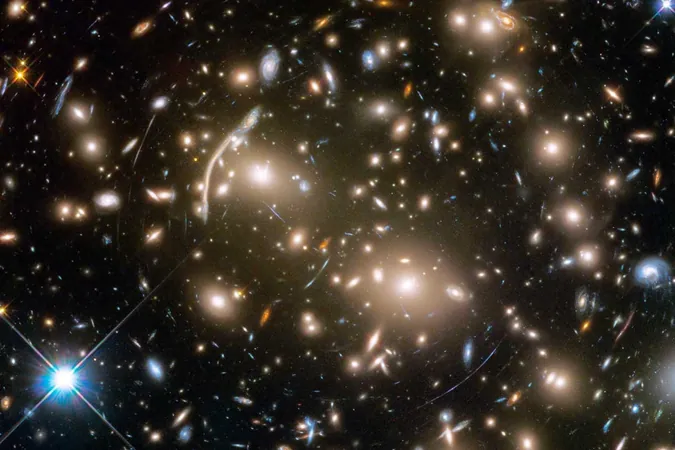
Groundbreaking Discovery: The 'Einstein Zig-Zag' Gravitational Lens Could Unlock Cosmic Secrets!
2024-11-15
Author: Li
Introduction
In a revolutionary find that could reshape our understanding of the universe, astronomers have identified a unique gravitational lens dubbed the 'Einstein Zig-Zag' within the cosmic landscape. Initially thought to be a simple galaxy bending light from a distant active galactic core, further examination has confirmed that this intriguing object, known as J1721+8842, is actually a rare dual-lens system formed by two galaxies perfectly aligned.
Discovery and Observation
Discovered in 2017, the J1721+8842 system sparked interest as it appeared to be bending light from a distant quasar, a highly energetic galactic nucleus. However, after two years of meticulous observation using the Nordic Optical Telescope and data gathered from the cutting-edge James Webb Space Telescope, researchers have revealed that the light from this distant source travels through the lens in a captivating zig-zag pattern. This discovery has been detailed in a recent submission on the preprint server arXiv, highlighting the potential of this compound lens to unravel fundamental cosmic mysteries.
Significance of Gravitational Lenses
The research team elaborated, “Our findings from the light curves captured at the Nordic Optical Telescope, alongside new redshift measurements from the James Webb Space Telescope, confirm that a single source is indeed lensed in J1721+8842.” Gravitational lenses possess the remarkable ability to bend and magnify light from distant cosmic objects, enabling astronomers to observe phenomena that would otherwise remain undetectable. This optical-magnifying effect was first proposed by Albert Einstein in 1912.
Applications in Cosmology
Gravitational lenses are not just fascinating phenomena; they serve as powerful tools that can provide insights into the early universe. For instance, in 2022, scientists utilized a gravitational lens to identify Earendel, the oldest known star, shedding light on the universe's formative years. Furthermore, gravitational lenses often create stunning rings of light known as Einstein rings, which have recently contributed to the search for elusive particles like axions that may account for dark matter—an area of intense research in astrophysics.
Recent Lensing Discoveries
Earlier this year, researchers at Lawrence Berkeley National Laboratory identified a remarkable gravitational lens configuration likened to 'eight needles lined up in a haystack,' which unveiled an Einstein Cross, showcasing the symmetrical distribution of mass, including dark matter, across the lens.
The Unique Structure of J1721+8842
However, J1721+8842 distinguishes itself with its unprecedented zig-zag structure, leading to its designation as the first-ever 'Einstein zig-zag lens.' Researchers emphasize the significance of this structure, as it could provide new measurements related to the Hubble constant, a critical value describing the rate of the universe's expansion. Known as the Hubble tension, the discrepancy in measurements of this constant is an ongoing conundrum for cosmologists.
Implications for Cosmology
Insightful probing of this double-lens system could help reconcile the differing calculations of the Hubble constant with the established cosmological models, thus advancing our comprehension of the universe's expansion history. As the researchers noted, the Einstein Zig-Zag offers an exciting opportunity to illuminate the ratio of distances between the observer, the lens, and the two galaxies involved.
Conclusion
In the grand pursuit of understanding our universe—its origins and evolution—state-of-the-art telescopes abound, enabling astronomers to glimpse back in time. Yet, it is the gravitational lenses that enhance the effectiveness of these tools, revealing distant cosmic wonders that pique humanity's curiosity. The J1721+8842, with its moniker of Einstein Zig-Zag, undoubtedly captures the imagination, making it a remarkable beacon in the quest for answers that lie well beyond our solar system.
Future of Cosmic Research
Will this cosmic discovery lead to new insights into the fabric of the universe? Stay tuned as researchers continue to peel back the layers of the cosmos!

 Brasil (PT)
Brasil (PT)
 Canada (EN)
Canada (EN)
 Chile (ES)
Chile (ES)
 España (ES)
España (ES)
 France (FR)
France (FR)
 Hong Kong (EN)
Hong Kong (EN)
 Italia (IT)
Italia (IT)
 日本 (JA)
日本 (JA)
 Magyarország (HU)
Magyarország (HU)
 Norge (NO)
Norge (NO)
 Polska (PL)
Polska (PL)
 Schweiz (DE)
Schweiz (DE)
 Singapore (EN)
Singapore (EN)
 Sverige (SV)
Sverige (SV)
 Suomi (FI)
Suomi (FI)
 Türkiye (TR)
Türkiye (TR)